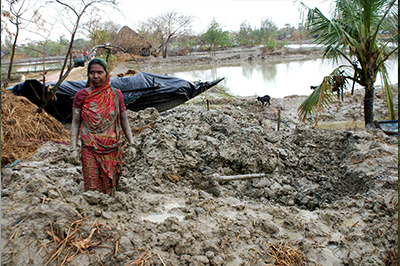 Children in Shyamnagar Upazila, Bangladesh
Bangladesh is more vulnerable to the effects of climate change than many other nations for a range of reasons. Firstly, it is vulnerable because it is coastal, low lying and subject to severe tropical cyclones and storm surges. Secondly, it is a poor country (Oxfam, 2017). Unlike richer nations, it does not have the economic resources to adapt to the effects of climate change with protection measures, such as sea walls, nor the means to cope with the consequences of large storms and devastation of people’s homes and livelihoods.
Children in Shyamnagar Upazila, Bangladesh
Bangladesh is more vulnerable to the effects of climate change than many other nations for a range of reasons. Firstly, it is vulnerable because it is coastal, low lying and subject to severe tropical cyclones and storm surges. Secondly, it is a poor country (Oxfam, 2017). Unlike richer nations, it does not have the economic resources to adapt to the effects of climate change with protection measures, such as sea walls, nor the means to cope with the consequences of large storms and devastation of people’s homes and livelihoods.
The people of Bangladesh are used to living with water and the sea. The south-west of Bangladesh is characterised by low-lying lands, with dwellings and fields protected by earth embankments. It is a coastal region subject to the tropical storms and cyclones which cause flooding and surges inland from the sea. Many livelihoods revolve around fishing and cultivation techniques which have been adapted over centuries to the region’s low-lying position. However, livelihoods which are already precarious are becoming more difficult to sustain as storm surges become more frequent and sea-level rise continues.
 A shrimp seller in Khulna, Bangladesh
Cyclone Aila
A shrimp seller in Khulna, Bangladesh
Cyclone Aila
Kolbari village lies in Khulna, in the South West of Bangladesh. In the 2009 Cyclone Aila, water from the sea surged over embankments along the Kholpetua river. Kolbari, which is located on the river was devastated by flooding. Sirajul’s family home and land where he cultivated shrimp was inundated by seawater. The family was forced to move to Shyamnagar, 15 kilometres away, where he found temporary work while the water retreated. When he returned after 4 months the saltwater had left his field unsuitable for raising shrimp, effectively ending the basis of his family’s survival. 190 people are estimated to have died from the cyclone and 2 million are displaced across the south-west of Bangladesh (Shelter Projects, n.d.).
The stories of death and devastation from catastrophic weather events such as Aila are repeated in many other places across Bangladesh and these events are increasing in number and intensity (ClimateChangeNews, 2014). Sirajul and his family could not return home, so they migrated to Dhaka the capital city (ClimateChangeNews, 2014). For many like Sirajul climate change is just one of many factors which have led to him making the difficult decision to move to the city.
 A women following Cyclone Aila
Population displacement
A women following Cyclone Aila
Population displacement
Many people in Bangladesh have had to leave their homes to migrate to other parts of the country. One migrant Moneja Begum explained that: ‘We have nothing to survive on…Everything has gone to the stomach of the sea’ (Oxfam, 2017, p. 19). Large numbers of people are relocating to the cities to live in squalid slums. Many people travel even further and make risky journeys across borders to find work, mostly illegally. The evidence shows that women and children who are displaced and migrate are particularly at risk of exploitation and gender-based violence. They are also less likely to be able to access help (Oxfam, 2017). There are up to 20 million people from Bangladesh living illegally in India (IDMC, 2014). It is estimated that an average of 21.8 million people across the world were internally displaced by extreme weather events each year between 2008 and 2016
Taking action for the future
There are many projects in Bangladesh developing adaptation measures to address the effects of climate change (UNDP, 2020). It is recognised that the best way of creating effective adaption plans is to empower those groups most affected (Oxfam, 2017). Community groups, across the country, are devising ways of combating the challenges of climate change. These include techniques for harvesting rainwater and raising homes further off the ground (Christian Aid, 2020). Ingenious indigenous cultivation practices such as floating vegetable gardens are also being developed to suit different localities.
 A floating garden in Bangladesh
A floating garden in Bangladesh
See how the floating gardens work: https://www.youtube.com/watch?v=_JatsIs73RA
It is important to stress that the people of Bangladesh did not create the problem of climate change. As Stephen Pacala said in 2007: ‘The 3 billion poorest emit essentially nothing’ (greenhouse gases) (Palaca, cited by Blackmore, 2013). It is therefore the responsibility of those of us who live in wealthy countries to address the impacts of the industrialisation that we have benefited from.
EXPLORE FURTHER: To see how Tuvalu is coping with the effects of sea-level rises, click here. Too see how your local area might be affected, follow this link to the map produced by Climate Central, based on the recent paper by Kulp and Strauss (2019).





Rate and Review
Rate this article
Review this article
Log into OpenLearn to leave reviews and join in the conversation.
Article reviews